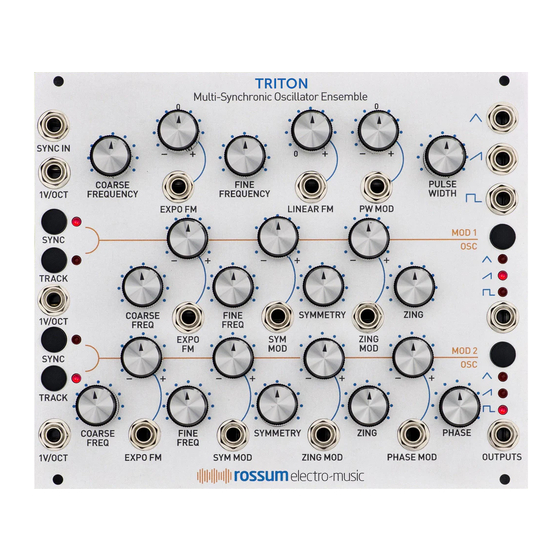
Table of Contents
Advertisement
Quick Links
TRIDENT
Multi-Synchronic Oscillator Ensemble
Thanks for purchasing (or otherwise acquiring) Trident. This guide will get you up and
running with a minimum of fuss. For lots more details, be sure to check out the full
owners manual at:
www.rossum-electro.com/support/documentation
What is this thing?
Trident is a 100% analog, triple oscillator
module that opens up a universe of
dynamic timbral textures.
At its most basic, Trident is three precision
VCOs, each sporting a unique variety
of control voltage inputs. And while
each VCO can be used independently if
desired, it's when they're combined into a
synchronous ensemble that the real sonic
magic happens.
That magic is what we call Zing
Modulation, where one or both of the 2
Mod Oscillators can modulate each of
the main Carrier Oscillator's outputs in an
amount controlled by the Zing parameter.
When a Mod Oscillator's Sync button
is on, the typical aharmonic sidetones
of ring modulation transform into
complex but purely harmonic overtone
spectra, which vary dramatically with
the frequency and waveshape of the
Mod Oscillators. Each change of a Mod
Oscillator's parameter will have a different
effect on the timbre of each of the three
Carrier waveshape outputs.
Installation
While all Rossum Electro-Music modules
are protected against damage to the
module or your system from reverse
polarity, care should still be taken to
connect the power cable correctly.
Plug the 16-pin connector into the header
on the rear of the module such that the
red stripe on the cable (the -12V side) is
on the same end of the header as the
"Red Stripe (-12V)" text on the PCB.
Trident requires a maximum of 290mA of
+12V and 270mA of -12V.
We have included both M3 and M2.5 (for
vector rails) mounting screws. Use what
fits your system.
If rack rash is of concern to you, use the
included nylon washers when mounting
Trident in your case.
Make some noise!
Given Trident's plethora of knobs and mod
inputs, experimentation is the order of the
day. To get you started:
Monitor the triangle output of the
>
Carrier Oscillator.
Turn up the Zing level of Mod 1 and
>
turn down the Zing level of Mod 2.
Ensure that Mod 1's Sync and Track are
enabled.
Vary Mod 1's Frequency, Symmetry,
>
Zing settings, and waveform and listen
to their effect. Try modulating the
parameters with external signals (or
with the output of Mod 2).
For dual Zing Modulation, turn up the
>
Zing on Mod 2 and vary its parameters
and waveform.
Try disengaging Sync and/or Tracking
>
on each Mod Oscillator and listen to
their effects.
Zing!
>
Advertisement
Table of Contents

Summary of Contents for Rossum Electro-Music TRIDENT
- Page 1 TRIDENT Multi-Synchronic Oscillator Ensemble Thanks for purchasing (or otherwise acquiring) Trident. This guide will get you up and running with a minimum of fuss. For lots more details, be sure to check out the full owners manual at: www.rossum-electro.com/support/documentation What is this thing? We have included both M3 and M2.5 (for...
- Page 2 Functional Overview SYMMETRY & SYM MODULATION (Mod Oscillators) Varies the duty cycle of the triangle wave output from sawtooth to triangle back to time reversed sawtooth, and also varies the sawtooth output to have an upward or downward kink in the middle. Sets the pulse width when the pulse waveform is selected.

Need help?
Do you have a question about the TRIDENT and is the answer not in the manual?
Questions and answers